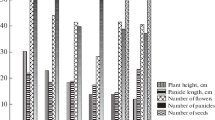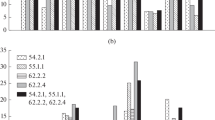Abstract
Gametoclonal variations were investigated in rice plants regenerated from anther-derived callus after subculture for two different periods (4–6 and 20 weeks) in medium with two levels (292 and 438 mM) of mannitol. A high osmotic stress by mannitol in subculture medium contributed to the maintenance of high regeneration ability. The frequency of diploid regenerants (R0 plants) increased and that of haploids decreased from callus subcultured for the longer period in medium with the higher concentration of mannitol. R1 regenerant lines displayed variations in all six agronomical traits studied at the frequencies of 63% and 88% after subculture for 4–6 weeks and 20 weeks, respectively. High homozygosity was suggested in most of the R1 lines for these traits by the similar levels of variance to those in the control variety. A principal component analysis showed a skewed distribution of variants towards dwarfness and less panicle weight in the regenerants from callus subcultured for 20 weeks with 438 mM mannitol. Two short culmn variants were shown to be due to single or double recessive mutations. The results suggested that prolonged subculture under high osmotic stress causes non-random selection of homozygous gametoclonal variations in rice anther culture.
Similar content being viewed by others
References
Adkins, S.W., R. Kunanuvatchaidach & I.D. Godwin, 1995. Somaclonal variation in rice - drought tolerance and other agronomic characters. Aust J Bot 43: 201-209.
Chen, C.C. & C.M. Chen, 1980. Changes in chromosome number in microspore callus of rice during successive subcultures. Can J Genet Cytol 22: 607-614.
Chu, C.C., 1975. Establishment of an efficient medium for anther culture of rice through comparative experiments on nitrogen sources. Sci Sin 18: 659-668.
Demarly, Y., 1986. Experimental and theoretical approach of in vitrovariation. In: J. Semal (Ed.), Somaclonal Variations and Crop Improvement, pp 84-99. Gembloux, Belgium.
Devaux, P., A. Kilian & A. Kleinhofs, 1993. Anther culture and Hordeum bulbosum-derived barley doubled haploids: mutations and methylation. Mol Gen Genet 241: 674-679.
Evans, D.A. & W.R. Sharp, 1983. Single gene mutations in tomato plants regenerated from tissue culture. Science 221: 949-951.
Fukui, K., 1983. Sequential occurrence of mutations in a growing rice callus. Theor Appl Genet 65: 225-230.
Gamborg, O.L., R.A. Miller & K. Ojima, 1968. Nutrient requirements of suspension cultures of soybean root cells. Exp Cell Res 50: 151-158.
Hirochika, H., 1993. Activation of tobacco retrotransposons during tissue culture. EMBO J 12: 2521-2528.
Hirochika, H., K. Sugimoto, Y. Otsuki, H. Tsugawa & M. Kanda, 1996. Retrotransposons of rice involved in mutations induced by tissue culture. Proc Natl Acad Sci 93: 7783-7788.
Hoffman, F., E. Thomas & G. Wenzel, 1982. Anther culture as a breeding tool in rape. Theor Appl Genet 61: 225-232.
Kanda, M., S. Kikuchi, F. Takaiwa & K. Oono, 1988. Regeneration of variant plants from rice (Oryza sativaL.) protoplasts derived from long term culture. Jpn J Genet 63: 127-136.
Kawata, M., S. Harada, B. Antonio & K. Oono, 1992. Protoclonal variation of plant regeneration in rice. Plant Cell Tissue Organ Culture 28: 1-10.
Larkin, P.J. & W.R. Scowcroft, 1981. Somaclonal variation - a novel source of variability from cell cultures for plant improvement. Theor Appl Genet 60: 443-445.
McCoy, T.J., R.L. Phillips & H.W. Rines, 1982. Cytogenetic analysis of plants regenerated from oat tissue. High frequency of partial chromosome loss. Can J Genet Cytol 24: 37-50.
Müller, E., P.T.H. Brown, S. Hartke & H. Lörz, 1990. DNAvariation in tissue-culture-derived rice plants. Theor Appl Genet 80: 673- 679.
Murashige, T. & F. Skoog, 1962. A revised medium for rapid growth and bioassay with tobacco tissue cultures. Physiol Plant 15: 473- 493.
Nakamura, K., H. Suzuki, K. Hattori & Y. Futuhara, 1994. Identification of ploidy level of the regenerated plants by anther culture in rice. Breed Sci 44: 19-22.
Ogura, H., J. Kyozuka, Y. Hayashi, T. Koba & K. Shimamoto, 1987. Field performance and cytology of protoplast-derived rice (Oryza sativa): high yield and low degree of variation of four japonica cultivars. Theor Appl Genet 74: 670-676.
Oono, K., 1978. Test tube breeding of rice by tissue culture. Trop Agric Res Series 11: 109-123.
Oono, K., 1983. Genetic variability in rice plants regenerated from cell culture. In: Cell and Tissue Culture Techniques for Cereal Crop Improvement Proceedings, pp 339-358. Gordon and Breach, Science Publishers, New York.
Oono, K., 1985. Putative homozygous mutation in regenerated plants of rice. Mol Gen Genet 198: 377-384.
Sathish, P., O.L. Gamborg & M.W. Nabors, 1995. Rice anther culture: callus initiation and androclonal variation in progenies of regenerated plants. Plant Cell Rep 14: 432-436.
Sibi, M., 1986. Non-menderian heredity. Genetic analysis of variant plants regenerated from in vitroculture. In: J. Semal (Ed.), Somaclonal Variations and Crop Improvement, pp 55-83. Gembloux, Belgium.
Yamamoto, T., Y. Soeda, A. Nishikawa & H. Hirohara, 1994. A study of somaclonal variation for rice improvement induced by three kinds of anther-derived cell culture techniques. Plant Tiss Cult Lett 11: 116-121.
Yoshida, S., M. Iwai, K. Watanabe & M. Fujino, 1998. Stimulatory effect of sugar-alcohol during subculture on green plant regeneration in anther-derived callus of rice. Plant Cell Rep (in press).
Author information
Authors and Affiliations
Rights and permissions
About this article
Cite this article
Yoshida, S., Watanabe, K. & Fujino, M. Non-random gametoclonal variation in rice regenerants from callus subcultured for a prolonged period under high osmotic stress. Euphytica 104, 87–94 (1998). https://doi.org/10.1023/A:1018699724552
Issue Date:
DOI: https://doi.org/10.1023/A:1018699724552




